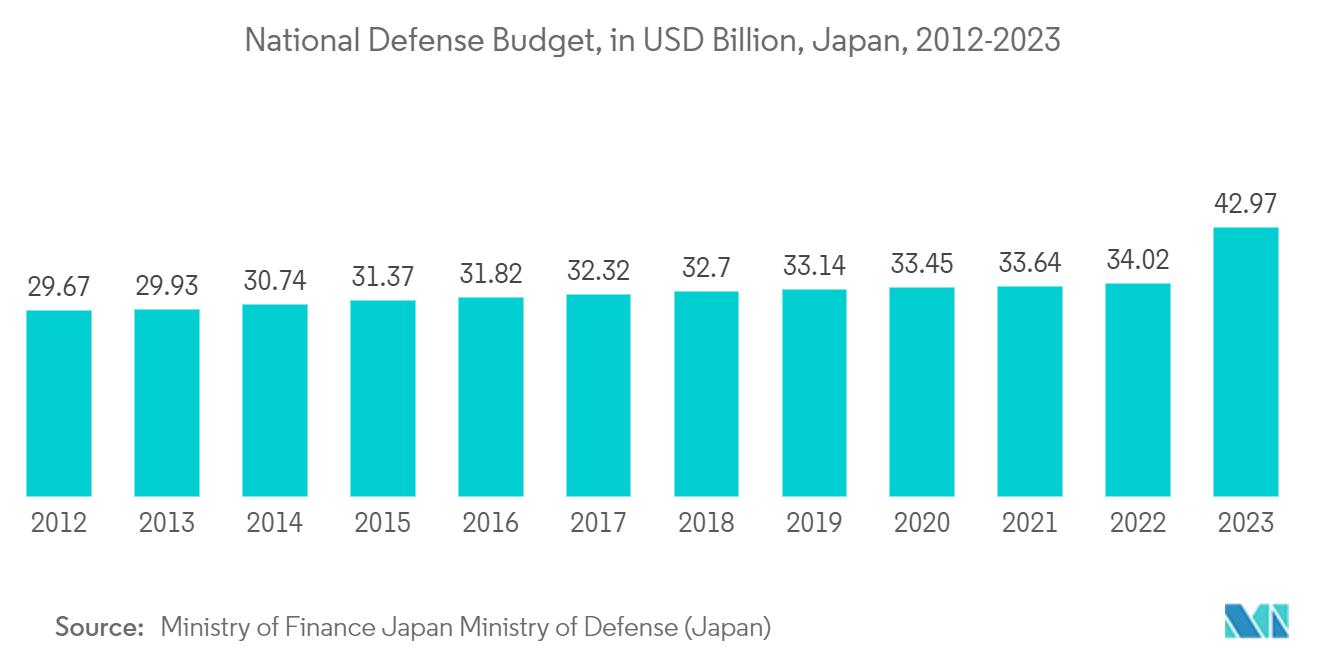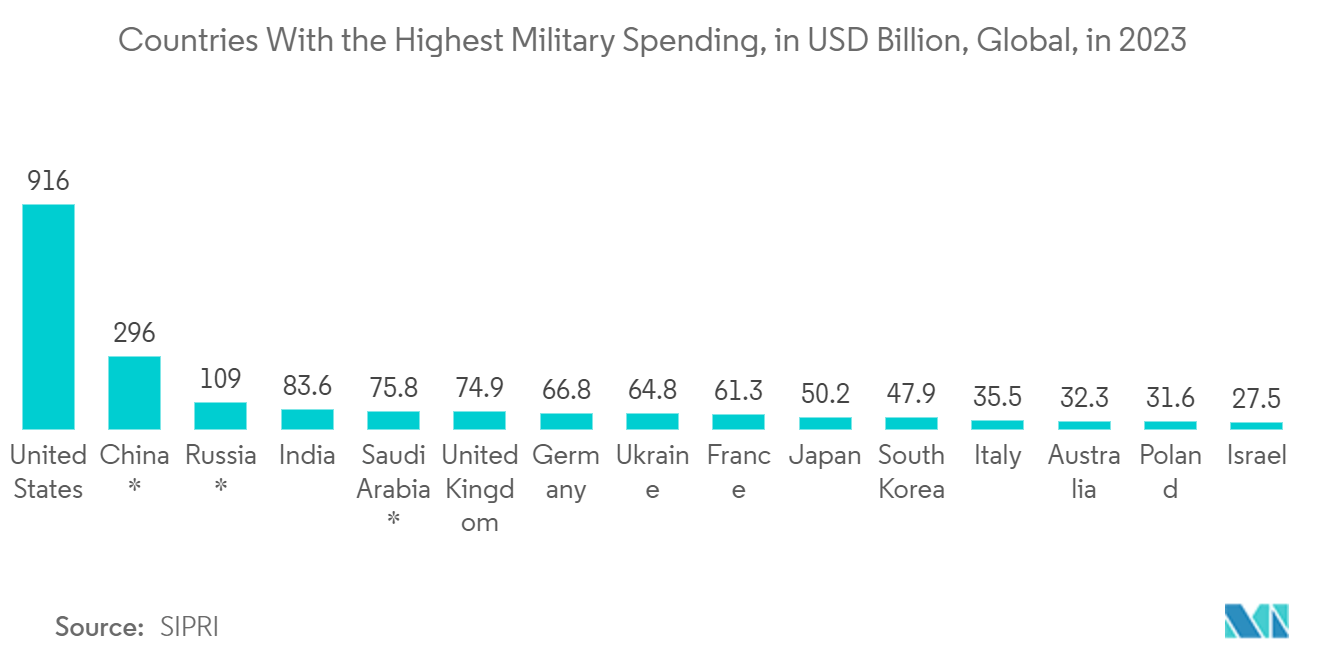Market Trends of APAC Semiconductor Device Industry In Aerospace & Defense Industry
Increase in Defense Budgets Across the Globe are Expected to Drive the Market's Growth
- Semiconductor devices have various applications in the defense industry, ranging from advanced radar and communication systems to military-grade devices used by various defense departments. Advanced semiconductors play an essential role in the defense industry particularly in electronic components for sophisticated military systems. Gallium nitride (GaN) semiconductor devices, in particular, areincreasingly used in defense and aerospace applications due to their high performance, high efficiency, and ability to operate in harsh environments.
- Additionally, it is anticipated that the expansion of aircraft modernization and modifications will be a major driver of semiconductor industry growth in the defense sectors. To ensure pilot safety, aircraft manufacturers have primarily concentrated on updating and improving their products. The need to replace the outdated cathode ray tubes used in airline screens is growing more and more urgent. Display panels must be lighter and more technologically advanced if emissions are to be drastically reduced and significant fuel savings are to be realized. Consequently, a growing market will result from the rising demand for semiconductors used in aircraft electronic systems.
- The increase in defense expenditure in various regions across the globe is anticipated to boost the growth of the studied market. For instance, the Indian Union Budget for FY24 envisages a total outlay of USD 550 billion. USD 72 billion or 13.18% of the overall budget has been allotted to the Ministry of Defense. The entire defense budget represents an increase of USD 8.35 billion, or 13%, over the budget for 2022-23. The non-salary revenue/operational allocation has been raised from USD 7.63 billion in Budget Estimates 2022-23 to USD 11 billion in BE 2023-24 to support the maintenance of weapon systems, platforms, ships/aircraft, and their logistics, improve fleet serviceability, etc.
- Similarly, the 2023-2027 midterm defense strategy was unveiled by the South Korean Ministry of National Defense (MND) on December 28, 2022. The South Korean government announced that it would spend USD 268.8 billion over the next five years, which translates to an annual rise in defense spending of almost 6.8%. The 'Korean Triad System,' which includes the 'Kill Chain' and allows for preemptive strikes in the event of any indications of North Korean strikes, will be acquired with a significant percentage of the government's budget being prioritized. The MND would spend money to purchase 20 F-35A stealth jets and KTSSMs (Korea Tactical Surface-to-Surface Missiles) for this.
- Moreover, according to Ministry of Défense (Japan), in the fiscal year 2023, Japan's national defense was initially allocated JPY 6.82 trillion (USD 43 billion). In comparison to prior years, this was a significant rise as a result of the Japanese government's new policy to strengthen the country's defense capabilities. Such huge spending in defense would drive the demand for the studied market.

China is Expected to Witness a High Market Growth
- China has a thriving aerospace and defense industry, primarily overseen by the Aviation Industry Corporation of China (AVIC), a state-owned conglomerate. In addition to AVIC, there are other major players in the Chinese defense market, such as Sinoma International Engineering, Avicopter, China Aerospace Science and Technology Corporation (CASC), China Electronics Technology Group, etc. China also boasts an extensive range of military aircraft. The presence of prominent aerospace and defense players in the country is likely to offer lucrative opportunities for the growth of the studied market.
- The Chinese government is undertaking several measures to advance its aerospace and defense industry. For instance, China's new five-year plan for 2021-25, announced in March 2021, established a comprehensive plan for boosting basic research as a critical priority. Semiconductors have been designated as one of the seven areas given priority in terms of resources and funding. Firms involved in designing and developing nanometer-scale integrated circuits that perform the primary tasks that make electronic devices work, such as computing, storage, network connectivity, and power management, are given significant importance.
- Further, China recently established various committees and policies to promote and regulate the development of its domestic integrated circuit (IC) industry. The Ministry of Industry and Information Technology established the National Integrated Circuit Committee to set standards and promote the industry. The Chinese government released guidelines and policies, such as the National Integrated Circuit Industry (National IC Plan) and the China Integrated Circuit Investment Industry Fund, to support the development of the industry. Additionally, China implemented export controls on advanced computing integrated circuits (ICs). Such policies and standards would ensure integrated circuits' quality and efficient functioning.
- Moreover, the number of newly registered chip-related companies in China more than tripled in the first five months of 2022 from the same period in the last two years. It is a new sign that China is sparing no effort in its goal of self-sufficiency in semiconductors, for which the country relied heavily on imports and US technologies to satisfy domestic demand. To that extent, in 2022, Semiconductor Manufacturing International Corp (SMIC) set aside USD 5 billion for capital spending, up from USD 4.5 billion in 2021.
- In March 2022, according to draught budget recommendations, the Chinese government proposed a defense budget of USD 230 billion for 2022, a 7.1% rise year on year. China's increase in defense spending coincides with the People's Liberation Army's increasing muscle-flexing in the vital Indo-Pacific. In March 2023, China announced a draft budget 023, which would see the country's annual defense budget rise to CNY 1.5537 trillion (USD 0.21 billion), an increase of 7.2% from 2022. The increasing defense budgets in the country are likely to boost the growth of the studied market. According to SIPRI, China's military spending in 2023, is USD 296 billion.

APAC Semiconductor Device Market In Aerospace & Defense Industry Report Snapshots
- APAC Semiconductor Device Market In Aerospace & Defense Industry Market Size
- APAC Semiconductor Device Market In Aerospace & Defense Industry Market Share
- APAC Semiconductor Device Market In Aerospace & Defense Industry Market Trends
- APAC Semiconductor Device Market In Aerospace & Defense Industry Companies

